Whitby’s Station Gallery
© By John Arkelian
“Art is a way of recognizing oneself.” (Louise Bourgeois, 1911–2010)
Art is a way for us to recognize essential truths about ourselves and the world in which we live — giving us a window into the human condition that empowers us to transcend the many things, from geography to gender, that anchor us in our own particular here and now. For the past 52 years, Whitby’s Station Gallery has been one of the jewels in Durham Region’s cultural crown from its distinctive home in what once was the Grand Trunk Railway Station. What started as a gleam in the eye of local art enthusiasts had its grand opening on September 26, 1970, and it has never looked back. (Indeed, two of its founders, Bill & Mary Irwin, have been actively involved from day one.) A box car was pressed into service as a printmaking studio, the gallery building got official heritage designation in 1980, and the whole facility moved, bodily, across the street in 2005 — with its newly expanded 10,000 sq. ft. providing more room for exhibits, studios, collection storage, and administration. But the goal has never changed, and that is “to bring art to the community through education as well as wider appreciation,” says the gallery’s new Executive Director, Natasha Downes.
After six years at the gallery, Downes took on the top job in September 2021, and, COVID obstacles notwithstanding, she has presided over a record-breaking year. The annual juried youth exhibition, “Art Attack,” attracted over 650 people for its opening ceremony. Now, that’s a crowd at a modestly sized venue, one that had patrons lined up around the proverbial block. The 230 works on display was likewise a record for the gallery. Other record-breakers aren’t hard to find: the upcoming “Drawing for Art” fundraiser has over 170 donated pieces; this year’s Summer Camp was bigger than ever; social media engagement has never been more active; and, at the gallery’s biweekly “Thursday Night Live” events, over 180 people assembled on the outdoor patio for live music. Hopes are high for the Annual Juried Show in November and December: anyone can submit work, with categories for different age groups.
The Station Gallery has had five Executive Directors (including an interim leader) over the years, It is open to art of all genres, with “contemporary” as good a signifier as any; but it aims to give a home to art from six minority categories, namely: aboriginal, francophone, artists of color, those who are deaf or otherwise disabled, younger artists (aged 18-30), and artists outside of the great metropolis. To that priority list, promulgated by the Ontario Arts Council, the gallery also likes to show local and LGBTQ artists. The gallery takes great pride in its role as an art educator. A full schedule of in-gallery classes resumes this fall, with 30 classes geared for various age categories, as well as one and two-day workshops, and periodic curator tours. And, the gallery’s outreach program is apt to include pop-up events in unexpected places away from the gallery itself. There have been two major art donations to the gallery in recent months — in the form of two indigenous sculptures and a collection worth $15,000 by intaglio printmaker Dan Steeves. As to funding, the Station Gallery gets 49% of its financial support from the Town of Whitby. Federal and provincial programs, foundations, and private donors make up the balance, with some additional support from corporate sponsors and the Region of Durham.
In the seemingly interminable age of the pandemic, the gallery has also hit upon the expedient of 3-D tours available online. It will be a staple going forward, but it got its start in April 2022 with the gallery’s “Hold Fast” exhibition. In response to the deplorable and lawless invasion of Ukraine by Putin’s Russia on February 24, 2022, the gallery’s Curator, Olexander Wlasenko, created an exhibition by eight Ukrainian-Canadian artists. An artistic blitzkrieg, the show was up-and-running a mere five weeks after the war began. “No one else in Canada was doing it. We were at the cutting edge.” The artists — so disparate in style and stage of artistic experience — had one thing in common, and that was the proud celebration of Ukraine’s “free, national character.” In addition to the wanton loss of life and the displacement of millions of people, Putin’s war of aggression has also been an assault on the cultural fabric and heritage of a sovereign people: for instance, UNESCO has enumerated over 200 historically important buildings destroyed so far. The eight artists on show ran the gamut from those in the early stage of their careers to mid-career artists and on to established artists with international reputations. Two of the latter — Governor General Award-winner William Kurelek and Edward Burtynsky, the acclaimed chronicler of oversized industrial landscapes wrought by Man — are prominent household names. The objective, says Wlasenko, was “a cross-cultural dialogue [and] a prayer for Ukraine to overcome and heal in peace,” while the result was a thing of “grace and astonishing beauty.” What better way than that for art to help us recognize ourselves — in all our glory and squalor?
John Arkelian is founding editor of Artsforum Magazine and leads the Durham Council for the Arts as well as the Cinechats International Film Program.
Copyright © 2022 by John Arkelian.
Where to Find Them: The Station Gallery is situated at 1450 Henry Street in Whitby, not far from the 401 & Brock Street South. Contact them at (905) 668-4185 or at: art@stationgallery.ca. Or visit them online at: https://www.stationgallery.ca/
See the “Hold Fast” exhibit in support of Ukraine at: https://my.matterport.com/models/9GV3kyWzh1u?organization=ptGBeWGgPDg§ion=media
The foregoing profile also appeared in the Fall 2022 issue of Grapevine Magazine.
*****************************************
Art in Unexpected Places
The Stable Gallery
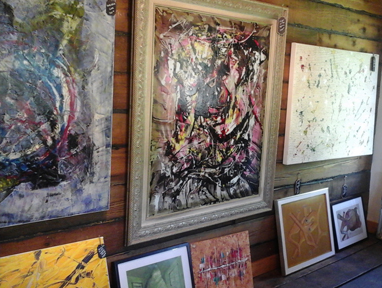
The Stable Gallery in Claremont, Ontario – photo © 2019 by John Arkelian.
© By John Arkelian
A verdant few acres in Claremont, Ontario are a countryside idyll (reminiscent perhaps of one of their current owners’ former home in Gloucestershire, England), with woods, meadows, pond – and art. It’s home to Bob and Dixie White, and not only have they filled their home with art, they’ve put Bob’s own work on display in a converted horse stable. Two-stories high, it is whitewashed on its lower half, and its stalls are now cozy exhibition spaces for Bob’s paintings. Upstairs, there are studios for painting and for wood-working. Bob came by his love for art at an early age: His debut watercolor at age 6 was re-imagined in oils three years later. These days, he favors acrylics. Offered a place at London’s esteemed Hornsey College of Art, Bob’s career took him in other directions (home design and renovations) instead; but, his passion

The Stable Gallery in Claremont, Ontario – photo © 2019 by John Arkelian.
for art never dimmed. His chosen style is abstract, and if there’s something vaguely organic (or even anatomical) looking about some of his pieces, it’s no coincidence. For a time, Bob was headed to a career in medicine; and a lifelong fascination with the human nervous and circulatory systems has found its fanciful way into some of his paintings. Bob says, “I wanted to be a surgeon; I ended up a ‘plumber.’ That’s where a lot of the ‘tubes’ come from.” Bob White’s art has been shown at Uxbridge’s ‘Art in the Park,’ the Durham West Art Show, and Markham Arts Council exhibitions. But there’s nothing quite so unique as viewing it in its own quixotic home: The converted stable is cool even under a blazing summer sun – and the juxtaposition of that old structure (intended for equine

The Stable Gallery in Claremont, Ontario – photo © 2019 by John Arkelian.
occupants) and the most modern of art is a pleasing one. If you linger till day’s end in the Whites’ beautiful, park-like setting, you’ll be serenaded by an amphibian orchestra from the nearby pond.
Text & images copyright © 2019 by John Arkelian.
Editor’s Note: The Stable Gallery is situated at 4395 Westney Rd. in Claremont, north of Pickering, Ontario. However, it (and the Whites) will be moving to new domiciles elsewhere in Durham in August 2019. Call (416) 574-4203 to arrange to see Bob White’s art. Or visit: https://www.facebook.com/Bobsabstracts/?rc=p
*****************************************
Art invades downtown spaces in Oshawa
© By John Arkelian
Fifteen days, more than a dozen venues, an urban setting, and one hundred
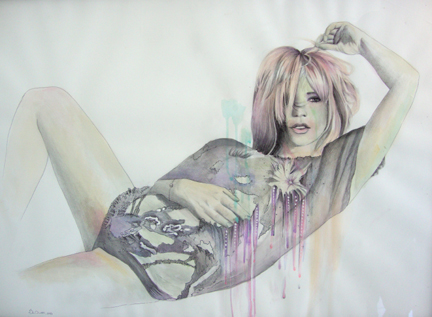
“Diagnosis” (ink and watercolor on paper) — Copyright © 2013 by Samantha Ouellette
artists — that’s the concept behind “Oshawa Space Invaders,” an art festival that turned empty storefronts into a surprisingly convincing variation on the sort of bohemian arts district you’d find in Toronto, Vancouver, or New York. Downtown Oshawa, bereft long ago of most of its oldest and best heritage buildings, has long been perceived as a dowdy, lifeless, and dull place — more given over to non-descript structures housing banks and hairdressing schools than to the rich diversity of retail stores (don’t look for a bookstore here) and cafes and theaters that draw people to more lively, cosmopolitan burghs. But, mayhap, the times, they are a changing. The presence of a university downtown (since UOIT outgrew its
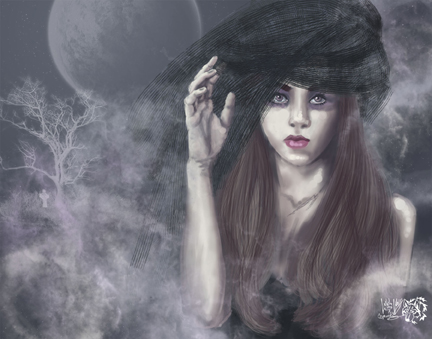
“Leave the Soul Alone” (Photoshop tablet art) — Copyright © 2013 by Aspenn Richards
main campus north of the city) has brought with it cohorts of young adults. A greater diversity of restaurants (including a sidewalk café or two) has followed in their wake, and, so, too, ever so slowly, has a modest increase in live entertainment — at the Regent Theater, the GM Center, and the small Arts Resource Center. The city’s estimable Robert McLaughlin Gallery has gotten into the act, too, with the happy innovation of monthly live entertainment events. Those changes, however modest, have been welcome ones. They may portend a trend-line that will reinvigorate what had hitherto seemed an uninspired downtown sector.
Change certainly seemed tangible on the night given over to the Artcrawl,
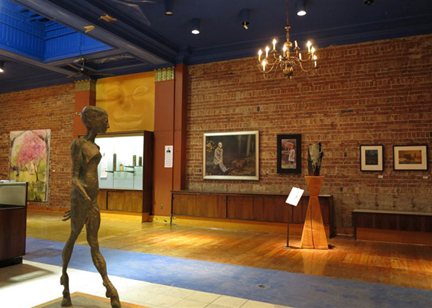
Space Invaders 2013: Art in the city — courtesy of Steven Frank
“Space Invaders’” keynote event. From 5 pm till 11 pm, on September 20, 2013, the normally moribund environs of Oshawa’s small downtown were transformed: Two side-streets became concert venues for ten live bands (including Juno Award-winning blues artist Jack de Keyzer), throngs of people ventured into the long neglected downtown byways, empty storefronts overflowed with art, and floodlights were poised to illuminate the night sky. The result was a pretty convincing imitation of a place filled with vitality and creativity, in place of the old one-horse (and one-industry) town demeanor that has (somewhat unfairly) dogged Oshawa (and to a lesser extent, the whole of Durham Region) over the years. “Space Invaders” is, in part, the brainchild of Steven Frank, who essayed something very similar in the same city some years ago. Its return is a felicitous splash of color in a too uniformly grey setting.
The co-curators of one of the “Space Invader” venues, Steve Longauer and Samantha Ouellete, see the event as “a long-awaited and highly positive experience for local artists and the community alike.” Their particular venue hosts art by young artists (many with a past or current connection to Paul Dwyer High School; others who are engaged with art studies at Durham College). So, for Longauer and Ouellette, the event was a tangible expression of potential – the artistic potential of their young artists and the civic potential of Oshawa itself — to become a more eclectic, exciting, and cosmopolitan sort of place: “This event lent itself well to the reinvention of Oshawa.” Let it be so.
Copyright © September 2013 by John Arkelian.
Space Invaders runs in downtown Oshawa, Ontario from September 13 through 28, 2013. For more information, visit http://www.oshawaspaceinvaders.com/media.html
*************************************************************
An Interview with Canadian Artist John Di Leonardo
© By Bradley McIlwain
John Di Leonardo received his Bachelor of Honours in Fine Art and Art History from McMaster University, and a Bachelor of Education from the University of Toronto in 1978. Since that time, he has continued to teach, lecture, as well as exhibit his own art for over twenty years. He recently retired from teaching at All Saints Catholic Secondary School, where he has continued to inspire young people with his passion for the arts. John’s artistic creations have been exhibited in venues such as Toronto’s Gallery 306; Northrop Fry Hall, Victoria College; St. Lawrence Centre, First Canadian Place, Art Dialogue Gallery, AGO Rental, and Station Gallery.
John recently sat down to talk about his creative process and reflect upon his experience as an artist and young man, emerging into the Toronto art scene in the 1980’s. His latest series of paintings, Book of Hours, were recently on display at the Bowmanville Public Library. John’s paintings are on view at http://gallery.me.com/jmkimage#100169&view=grid&sel=3
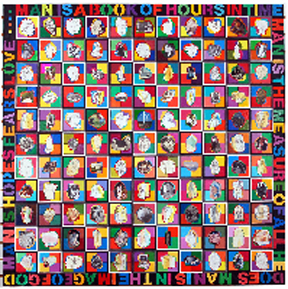
© John Di Leonardo
What are some of the steps you follow when creating a work of art?
I do a lot of reading. Mostly philosophy, a lot of poetry, and some fiction. I also draw on a regular basis, and from there the ideas and shapes start to form. The notion of the divinely inspired artist is very unusual – I’ve had that happen maybe twice, in thirty years, like when you’re driving along, and boom you get this flash of a finished painting in you’re head. Usually it’s through hard work, routine. You’re in the studio and you experiment, throw some paint around, and draw. Over time, if you keep feeding your subconscious with reading, visiting galleries, etc., eventually it comes. Then the work happens, and you get up in the morning and keep going at it, you grab your coffee, go in the studio, uninterrupted and painting all day – It’s as close to heaven as I’ll get (laughs).
Do you have any rituals when you paint?
I do have a ritual, not necessarily when I paint, but I do have one rule – that you’re in the studio for a minimum of four hours a day, if at all possible. Some days, you’ll go in and nothing happens – but the ritual is: you clean your brushes, straighten out the books, or stare, but you’ve got to be there. Eventually, something will catch your eye, and you start drawing. Before you know it, the work is on its way – you have your morning coffee, and eight hours will go by – and I’ll realize I haven’t eaten breakfast or lunch (laughs).
What materials do you enjoy working with?
I love oil painting; I think that’s my first love. But I like all of them. I find in works I tend to mix acrylics, oils, graphite, watercolors, collage, and photography, whatever attracts my attention or eye.
Are there any artists you feel have influenced your work?
I often get asked that question, “Who’s your favorite artist,” but all artists I love for various reasons. Picasso, I love his creative spirit; he tried anything with everything; Matisse for his color; Van Gogh for his spontaneity, and so on. There really isn’t one artist that stands out to me, but I do have preferences. Colour is very dominant in my work, and right now I’m reading a lot on conceptual art.
Do you have a preferred style?
I find the experimental approach the fastest way of getting ideas down. I get too many ideas, too fast to stick to one thing. Early on I did a lot of different styles. Lots of realistic paintings, surrealism, expressionism, all the ism’s. Eventually you settle in what’s comfortable for you, what reflects your personality.
What was it like for you breaking out into the art world as a young man in Toronto in the 1980’s?
Very exciting. In Toronto, out of art school, I had a studio with some friends on Dufferin and King. There were showings on a regular basis, we were going to galleries and openings three-four nights a week, really being on the hub of what was happening on Queen Street East at that time. Post-Expressionism was the leading style at the time, and I remember doing a whole series of very heavy ‘impasto’ expressionistic images. There’s a real energy and excitement when you’re young, a daring of just jumping-in. As you grow older, you’re more contemplative and careful of your work; it’s more about the quality. It takes a lot of honesty and confidence, and I think it comes with time.
You taught high school art professionally for a number of years. What was it like teaching in that environment?
I love teaching art. Young people always keep you on your toes, especially with fresh ideas, and new language every four or five years. The arts is very much one on one, and you tend to develop relationships with kids. I am always amazed at the creativity of young people; there aren’t any inhibitions. The truth just pours out, and that’s great. It’s what we need as adults; we keep forgetting that.
What are you most interested in exploring through art?
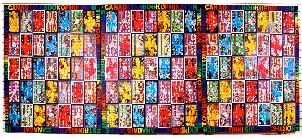
I think exploring how I feel about different aspects of life, and hopefully having other people examine and contemplate different aspects of their own as well. I see art as a spiritual exercise in some ways, where it can give you a heightened sense of yourself and feelings, or heighten what’s already in there. Certainly, I think art should always be positive, show a positive side in life, even in negative images, there should always be a sense of hope.
Your work was on display in Bowmanville, Ontario earlier this year. What can you tell me about that exhibition?
The works presented in the “Book of Hours” express different aspects of daily life, and often contrast physical and spiritual beauty… as a way of contemplation, enriching, and reawakening the inner self. The idea of progress really interests me, looking at how we grow as people, through the small day-to-day feelings [and] interactions. I meditate on those and tend to look at them in a wider scale, the global and the spiritual, hopefully getting a better understanding of others and myself
In your art, you use a lot of photographs and images from your family life. How has that made an impact on your work?
I think I was a little bit timid at first, but you say: this is what I do, this is who I am. It’s honest, you can’t withdraw images because it’s too personal, then you’re not being truthful to yourself or what you’re trying to express. I think your experience, whether it’s in writing form, or reflection or drawing or painting or photographs; it’s who you are. Something led you to take that photo or draw that thing: It’s part of your past and existence, so why deny it?
Do you have any advice for younger artists emerging onto the scene now?
Art is never easy. I think you have to work hard, be honest about what you’re doing. If you think you like to do art, just keep doing it. Being aware of what’s going on is important, like going to galleries and interacting with other artists, sharing ideas, and critiquing each other’s work, but more than anything be yourself. If you’re honest, your true self will come out.
What do you like most about the exhibition process?
Sometimes a really nice sense of surprise, like these works, where you produce and produce and you stack these works in the studio, and its cluttered and busy, and then you see your work in a new environment with clean walls and lots of breathing space around them. The painting presents itself in almost a different way, certainly bolder and speaks more directly. I also like people watching the work: That’s kind of neat.
Tell me about your current projects.
I’ve been getting flashes and images of very subtle whites on whites, and moving away from these bright bold paintings. I want to do something, and maybe it’s the idea of old age, retirement and quietude… reflection. I want to do some work that is very peaceful, very emotional, but very subtle, almost spiritual. I don’t know exactly what it is yet, but I know eventually something is going to happen and will start me off. I’m also writing poetry – I came back to it after thirty years. It was always there in the background.
Where will you go from here?
I think I’m in a good place mentally, having the time and health to keep painting and exploring. That’s all I want to do. Branching out, meeting people, trying new things. You need to constantly try new experiences to feed your subconscious, so that you bring new visions to your expression.
Bradley McIlwain is a writer based in Brooklin, Ontario.
Copyright © May 2010 by Bradley McIlwain.
